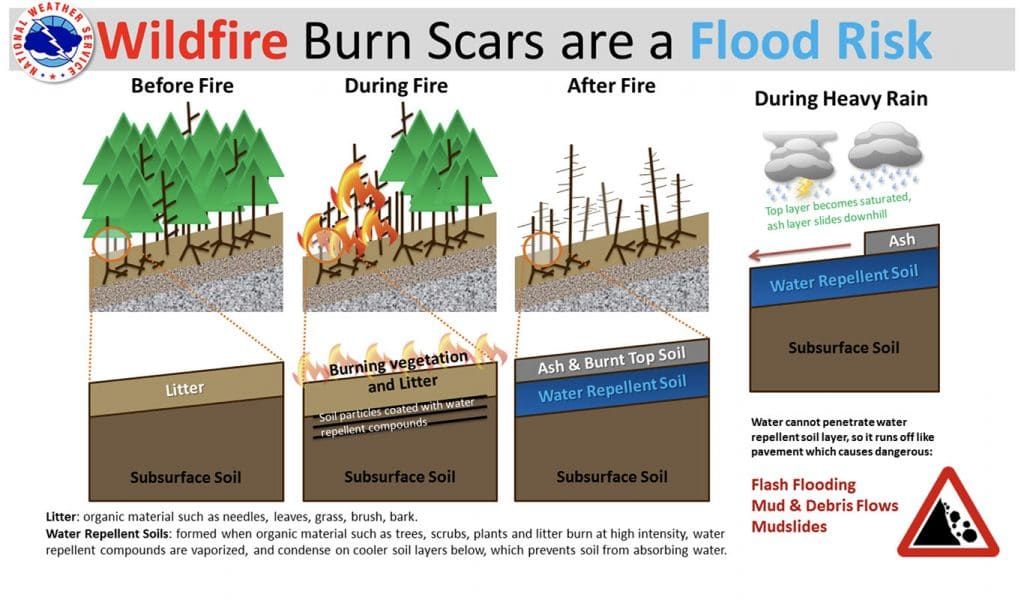Double whammy: After the fires, the mudslides begin
By Daisy Simmons | December 29, 2020
 Infographic courtesy of National Weather Service.
Infographic courtesy of National Weather Service.
Editor’s note: This story was originally published by Yale Climate Connections, an initiative of the Yale Center for Environmental Communication.
After a fire, rain can feel like a refreshing mercy. But it also spells fresh danger in fire-struck areas made newly vulnerable to mudslides. Amidst recovering from the trauma of a wildfire, people in hillside homes across much of the western United States, in particular, must now be ready to evacuate when threatening heavy rains appear in the forecast.
That’s because fires do more to the physical environment than level buildings and fell trees. They also alter the makeup of the soil, making it less likely it will absorb rainwater, especially during a downpour.
“The same intensity of rain can generate overland flows more than 10 times greater in areas recently burned compared to those without fire,” Arizona State University environmental engineer Mikhail Chester said in Popular Science.
To explain why fire-scorched land is more prone to mudslides, and what communities can do about it, let’s begin with the basics.
What causes a debris flow? On a typical hillside not recently burned, vegetation helps trap the soil in place. When rain pours down in a major storm, trees, shrubs, grasses, and leaf litter all help protect the soil from a heavy downpour, giving water more time to soak into the ground.
But when fire destroys that vegetation, there can be little left to keep soil and sediment from flowing down a steep hill—much less retain water there. What’s more, parched, fire-charred soil can become hydrophobic, which means it actually repels water, just as pavement does.
When intense rain falls on water-repellant ground, the water runs downhill quickly—more than double its usual rate—forming a river of mud and other debris. All the while, the expanding flow can pick up whatever it encounters along the way, from mud, rock, and sediment, to larger debris like fallen trees and limbs and boulders, depending on the severity of the rain and vulnerability of the soil.
The California Department of Water Resources advises that fast-moving debris flows can rock homes off their foundations and sweep away vehicles, creating life-threatening dangers.
The results can be tragic, as was the case in Montecito, California, in 2018, shortly after the deadly Thomas Fire laid bare much of the landscape. A half-inch of rain fell in just 15 minutes, unleashing a debris flow that was an estimated 25 to 30 feet deep, moving at roughly 10-15 mph, and capable of carrying boulders as big as a tow truck. The catastrophe claimed at least 21 lives, destroyed more than 100 homes, and shut down Highway 101, a major north-south route, for almost two weeks.
How fire-struck communities can mitigate the risk. Looking ahead, the likelihood of post-fire debris and mud flow is likely to increase, in large part because climate change is already leading to the intensity of more fires across the West. A joint study by Arizona State University and University of California-Los Angeles researchers found that the chances of post-fire debris flow risk will generally increase as climate change intensifies.
To protect people and property from this growing threat, communities should first and foremost be aware of the risks they and their populations face. The California Department of Conservation advises that residents of fire-struck areas be prepared for potential debris flows for as long as two-to-five years after major fires.
From there, communities that have recently experienced wildfire should consider the following safety tips:
Understand the risk at a local level. Visit the US Geological Survey’s post-fire debris-flow hazard assessments page for data-driven estimates on the probability and volume of debris flows in the aftermath of major fires in the western United States. Beyond that, heed the Centers for Disease Control (CDC) fact sheets about landslides and mudslides; expect that steep, burned hills will be more vulnerable to debris flows.
Be prepared to evacuate. Make sure you have an emergency evacuation plan. Listen to weather reports, and be ready to leave the area if heavy rains are on the way and you live on a hillside or downslope area that may be susceptible to mud or debris flows.
Know the signs of an impending debris flow. According to the CDC, warning signs include sudden changes in water level of a stream or creek, or trickling mud or rumbling sounds that might indicate approaching flow. Visit the Red Cross website for more detail on what to do before and during a mud or debris flow.

Together, we make the world safer.
The Bulletin elevates expert voices above the noise. But as an independent nonprofit organization, our operations depend on the support of readers like you. Help us continue to deliver quality journalism that holds leaders accountable. Your support of our work at any level is important. In return, we promise our coverage will be understandable, influential, vigilant, solution-oriented, and fair-minded. Together we can make a difference.
Keywords: California wildfires, climate change, climate crisis, climate refugees, evacuation, global warming, mudslides
Topics: Climate Change














